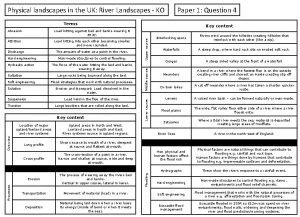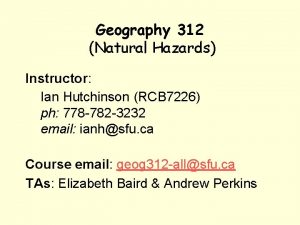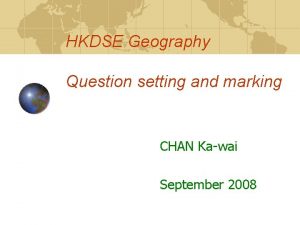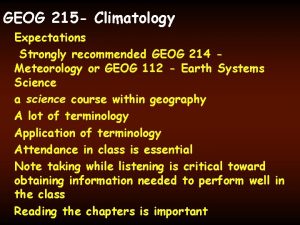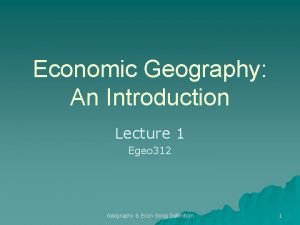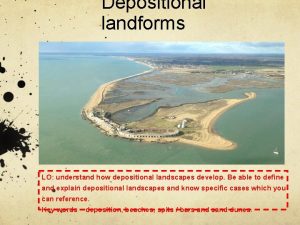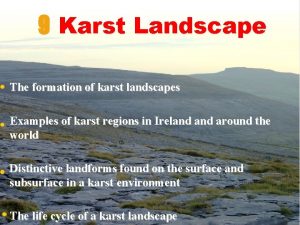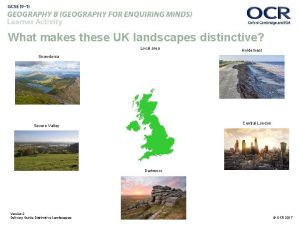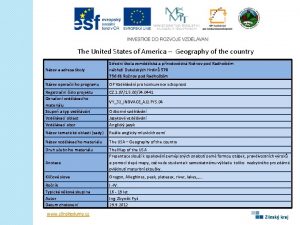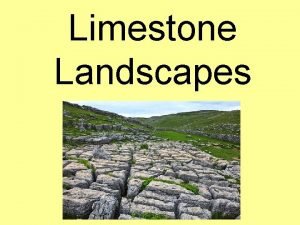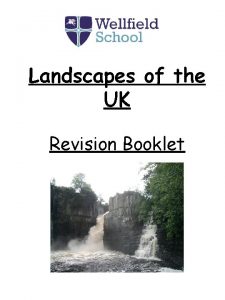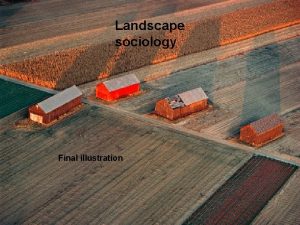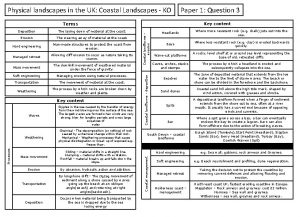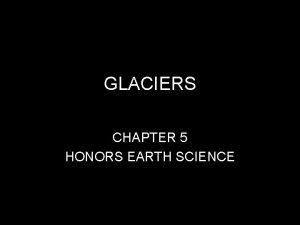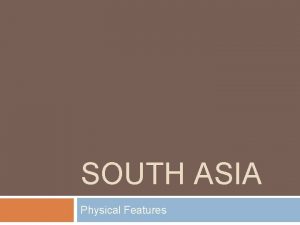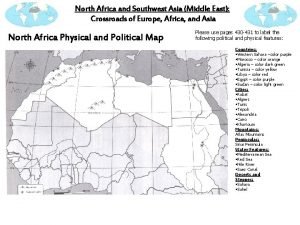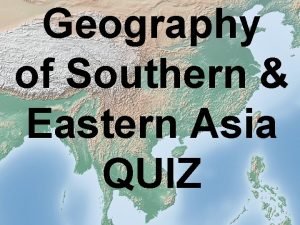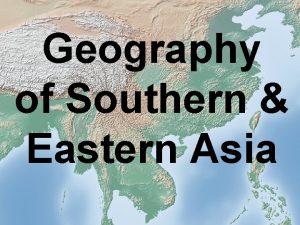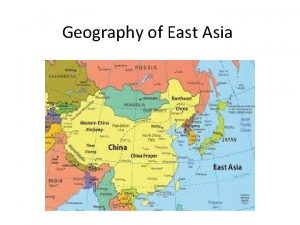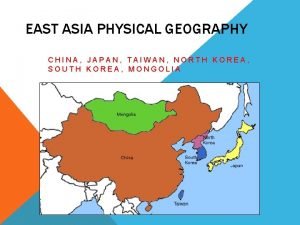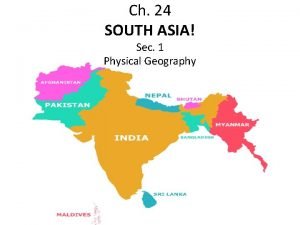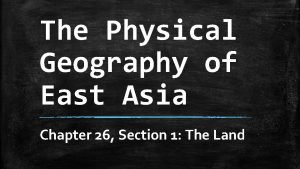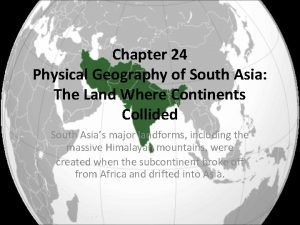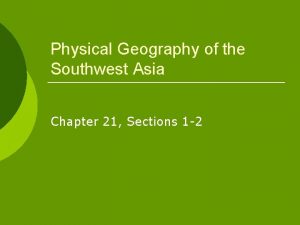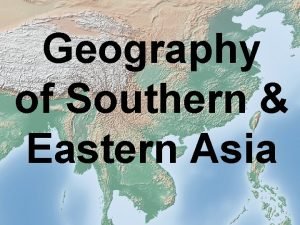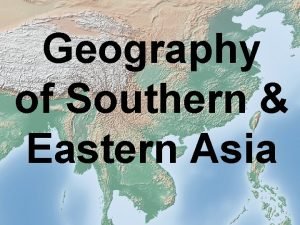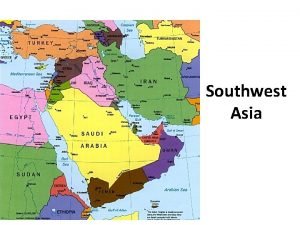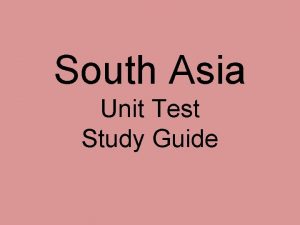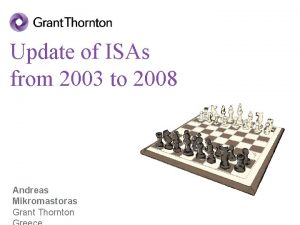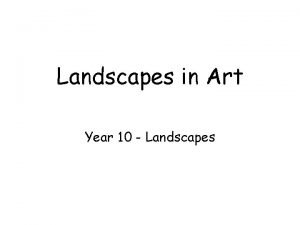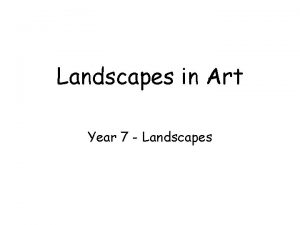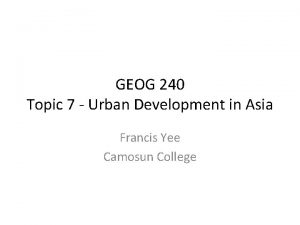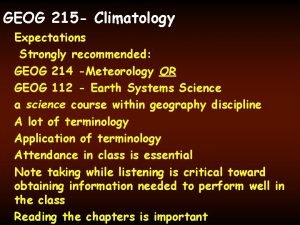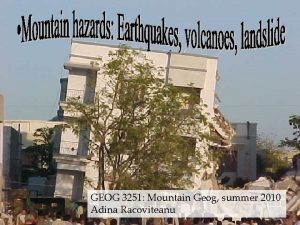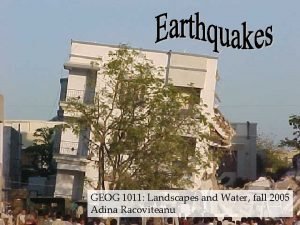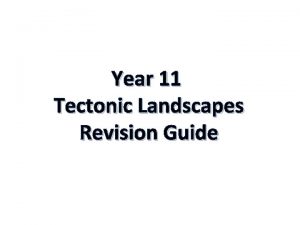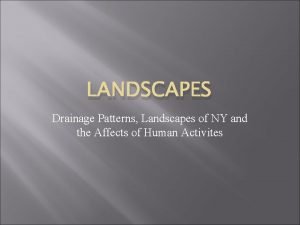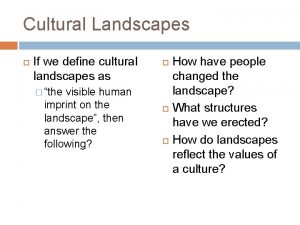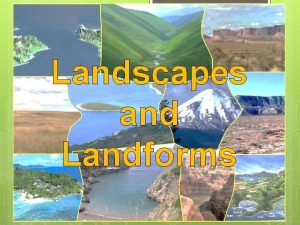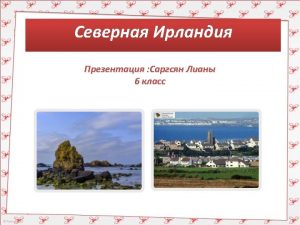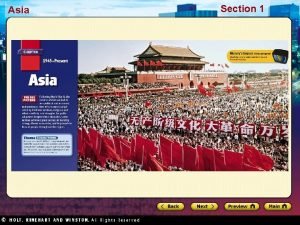GEOG 240 Unit II Physical Landscapes of Asia




![1. Mountains: steep and rugged [elevation >500 m] A view of Tian Shan Mt. 1. Mountains: steep and rugged [elevation >500 m] A view of Tian Shan Mt.](https://slidetodoc.com/presentation_image_h/3770e271da074e7332abf3ff1204379f/image-5.jpg)



































- Slides: 40

GEOG 240 Unit II - Physical Landscapes of Asia Pacific Francis Yee Camosun College

Physical Landscapes of Asia. Pacific I. III. Landforms Climate Vegetation Origin of Yangtze River in Tibetan Plateau (Photo by F. Yee, 2007)

I. Landforms 3 broad divisions of landforms A. B. Chinese Checkerboard (covered most parts of China) Alluvial Fan (included Mainland SE Asia) Island Realms (consisted of Maritime SE Asia, Taiwan & Japan)

A) Chinese Checkerboard: Consists of a mix of different landforms 1. Mountains 2. Plateaus 3. Plains 4. Basins
![1 Mountains steep and rugged elevation 500 m A view of Tian Shan Mt 1. Mountains: steep and rugged [elevation >500 m] A view of Tian Shan Mt.](https://slidetodoc.com/presentation_image_h/3770e271da074e7332abf3ff1204379f/image-5.jpg)
1. Mountains: steep and rugged [elevation >500 m] A view of Tian Shan Mt. (7, 439 metres) with few settlements & economic activities [Photo by F. Chow 2002]

2. Plateau (high elevation but level) Xizang (Tibetan) Plateau (>3, 000 metres) with sheep and cattle raising [Photo by F. Yee, 2007]

3. Plains– low lying areas suitable for farming and settlements Extensive farming area in Pearl River Delta, S. China (Photo by F. Yee, 2005)

4. Basins – low lying area surrounded by mountains Nanshan Pasture (Urumqi, W. China) for sheep & cattle raising (Photo by F. Chow 2002)

B. Alluvial Fan (S E Asia) Alluvial Fan: Lowlands, fertile soil, flood plains e. g. 1. 2. 3. Lowland farming in Myanmar (Photo by F. Yee 2005) Menam (Chao Phraya) (S. Thailand) Mekong Delta (S. Vietnam, Cambodia) Irrawaddy River (Myanmar)

Rice Farming in Bali, Indonesia a Subak system that integrated religion and production Rice farming in Bali, Indonesia (photo by F. Yee 2012)

C. Island Realms Characteristics: young fold mountains (high elevations, less eroded, unstable, young age) with large number of islands An extended Himalaya Mt. System: ◦ Geological Structure (tectonic plates): ◦ ◦ ◦ extends from China ->Nepal ->Burma>Sumatra->Java->Borneo->Philippines>Taiwan->Japan) Ring of Fire (Volcanoes) Earthquakes Tsunamis (tidal waves)

Plate Tectonics rigid plates float on top of the Earth’s mantle with movement of the plates causing seismic activities

Ring of Fire zones of high earthquake and volcanic activities (>150 active volcanoes in Asia-Pacific)

127 Active Volcanoes in Indonesia Tangkuban Perahu is a dormant volcano 30 km north of the city of Bandung, last erupted in 1959 (photo by F. Yee 2012)

Mt Fuji – highest mt. in Japan and an active volcano (one of Japan’s three holy mts. ) Photo by F. Yee, Mt. Fuji, Japan, 2013

Earthquakes: collisions of tectonic plates Major earthquake in Japan 2011 - Magnitude 9. 0, 15, 000 deaths (http: //www. huffingtonpost. com/news/japanearthquake)

Major Earthquakes in Asia Sichuan, China 2008, magnitude 7. 9, 87, 000 deaths (Details available from : http: //earthquake. usgs. gov/eqcenter/eqinthenews/2008/us 2008 r yan/#details) Kobe, Japan, 1995, M 6. 9, 5, 500 deaths Tangshan, China 1976, M 7. 5, 255, 000 deaths Taichung, Taiwan, 1999, M 7. 7, 2, 400 deaths Kanto, Japan, 1923, M 7. 9, 143, 000 deaths

Tsunamis: tidal waves from earthquake or volcanic eruption and travel long distance over large ocean areas Japan (2011): tsunamis impacted East coast of Honshu with runup of 37. 9 metre high and caused damage in Indonesia, California, Ecudaor, and Chile. Video showing tsunamis hitting Japan. http: //www. youtube. com/watch? v=80 CH_Xkp. SCE

Tsunami in Indonesia 2004 Quake magnitude - 9. 1, Impacts: 227, 000 deaths, 1 million people displaced, 13% coastal coral reefs damaged ◦ Details from USGS: http: //earthquake. usgs. gov/eqcenter/eqinthenews/2004/usslav/ ◦ Tsunami Images on affected areas: http: //www. pdc. org/PDCNews. Web. Articles/2004 South. Asia. Tsunam i/Information. Products/index. htm

II. Climate A. B. C. D. Monsoon Climate Temperature Precipitation Typhoons

A. Monsoon Climate : seasonal change of wind direction Wet Monsoon: wind pass through ocean and bring a lot of precipitation (from SW & SE)

Dry Monsoon wind pass through continent and bring little moisture (from NW)

B) Temperature 1. 2. East Asia a) Summer: little regional variation – high throughout (200 C to 280 C) b) Winter: North-South differences (cold in north [ -100 C in NE China], mild in south [100 C in S. China] Southeast Asia: Equatorial region - little seasonal variations (high year round)

Growing Season (continuous frost free days >50 C) varied from 130 days in NE China and 300 days in S. China

C. Precipitation: large variations due to location and seasons 1. Coastal (abundant) Vs. inland (little) a) >2000 mm: abundant in coastal areas of China and Vietnam, and equatorial areas of Indonesia, Malaysia, Singapore, the Philippines; b) 500 mm isohyets: scanty in NW China (grasslands and semiarid areas)

Precipitation in Asia 2. Seasonal: Summer (wet monsoon) Vs. winter (dry monsoon) a) East Asia - wet monsoon in summer (May – Sep) and dry monsoon (Oct – April); b) SE Asia: short dry monsoon in the equatorial region (only one month in Borneo and peninsular Malaysia

Precipitation in Asia: how much rain on average recorded in Taiwan and Mongolia?

D) Typhoons: (low pressure systems with high wind and heavy rain 1. Characteristics: atmospheric instability, warm sea temperatures, high humidity 2. Season: May to September 3. Typhoon Categories: i. Tropical storm: 63 -87 km/hr. ii. Typhoon: > 118 -149 km. /hr. iii. Super Typhoon – wind over 185 km/hr (Hurricane category 3 or 4), e. g. Utor in August 2013

Typhoon Tracks 3 main paths: originate from Pacific Ocean and move towards ◦ N Philippines Central China Japan / Korea ◦ Central Philippines Taiwan coastal China ◦ S. Philippines S. China Vietnam

Typhoon Vicenti Hit Hong Kong (July 2012) A #10 typhoon signal was posted in Hong Kong on July 23, 2012 with all air, land, and sea transport grounded. The Hong Kong International Airport airport was closed for several hours due to high wind (photo by F. Yee, 2012). Video on typhoon Vincente:

Super Typhoon Utor 2013 Tracks of Super Typhoon Utor with sustained winds over 240 km/hr, causing 25 deaths and 13 missing as well as US 2. 3 billion damage in the Philippines, Hong Kong, Macao, and China. Video showing Typhoon Utor in the Philippines. http: //www. bbc. co. uk/news/world-asia-23680782

III. Vegetation Affected by: 1. 2. 3. climate, aspects, altitude

A. Forests 1. Tropical Rainforest: ◦ dense forests rich in both plant and animal species ◦ Located in places with high temperature and abundant precipitation , e. g. equatorial SE Asia ◦ rapid lost of rainforest due to farming and other development

2. Tropical Monsoon Forests ◦ transition between rainforest and grassland, ◦ most trees are deciduous and use as firewood, ◦ rich collection of wildlife ◦ locate in Mainland SE Asia Monsoon Forest along the Mekong River in Burma (photo by F. Yee 2005)

3. Mid-latitude Forests: ◦ ◦ ◦ broadleaf deciduous forests in mid-latitude, drop leaves during winter (e. g. oak, birch, and elm), used for making furniture and other products Located in NE China, Japan, Korea Forested area near Mt. Fuji, Japan (photo by F. Yee 2013)

B. Mangrove coastal plants in tropical and subtropical inter-tidal regions (Vietnam, Cambodia, Philippines) plants adapted to saline conditions, generate large amount of organic matters, rich in fish and bird species, help to reduce coastal erosion, tsunami impacts, and maintain water quality Coastal plants along the Mekong Delta (photo by F. Yee 2010)

Steppe (Grassland) Grasslands in places with low precipitation, e. g. NW China, Inner Mongolia, important grazing land Soil erosion due to over grazing Grassland in Tibet Plateau (photo by F. Yee 2007)

Deserts Cold deserts: ◦ in high elevation with little moisture ◦ cold year round e. g. Tibet Plateau ◦ Gobi desert (1. 3 million sq. km. ) in Mongolia and China with cold winter and hot summer Hot Deserts: ◦ rainfall below 2. 5 cm; ◦ high temperature 2426 C; ◦ xeophytic vegetation, ◦ wildlife present but wind erosion severe Desert area in Gansu (photo by F. Chow 2001)

Mountain Vegetation ◦ altitudinal zonation of vegetation, ◦ ranging from tropical in the lower altitude to deciduous and grasslands in higher altitude until the tree line, ◦ e. g. Himalaya Mt.

Readings Weightman ch. 2
 Uk physical landscapes
Uk physical landscapes Unit 1 geog. of ga/ga’s beginnings
Unit 1 geog. of ga/ga’s beginnings Free floating subdivisions
Free floating subdivisions Geog 312 sfu
Geog 312 sfu Hkdse geography 2020
Hkdse geography 2020 Geog 214
Geog 214 Geog
Geog Fpm landscapes
Fpm landscapes Depositional landscape
Depositional landscape Limestone
Limestone What makes a landscape distinctive
What makes a landscape distinctive Region 5 themes of geography
Region 5 themes of geography What is this ?
What is this ? Landscapes and landforms booklet
Landscapes and landforms booklet Biosphere definition biology
Biosphere definition biology Etnorami appadurai
Etnorami appadurai Landscapes and landforms
Landscapes and landforms Morraine glacier
Morraine glacier South asia physical features map
South asia physical features map Southwest asia/north africa (swana) political map
Southwest asia/north africa (swana) political map Southern and eastern asia physical features answer key
Southern and eastern asia physical features answer key Southern & eastern asia physical features map
Southern & eastern asia physical features map Geography of asia
Geography of asia Taiwan physical geography
Taiwan physical geography Chapter 27 physical geography of east asia
Chapter 27 physical geography of east asia Lesson 1 physical geography of southeast asia
Lesson 1 physical geography of southeast asia Tear
Tear Physical geography of east asia
Physical geography of east asia South asia physical geography
South asia physical geography North africa and southwest asia physical geography
North africa and southwest asia physical geography Chapter 21 physical geography of southwest asia
Chapter 21 physical geography of southwest asia Physical features of southern and eastern asia
Physical features of southern and eastern asia Southern and eastern asia physical features
Southern and eastern asia physical features Southwest asia and north africa physical map
Southwest asia and north africa physical map Chapter 21 physical geography of southwest asia
Chapter 21 physical geography of southwest asia Unit 6 review questions
Unit 6 review questions South asia unit test
South asia unit test 150 nin 50 si kaçtır
150 nin 50 si kaçtır International standard on auditing 240
International standard on auditing 240 Hksa 240 (revised)
Hksa 240 (revised) 120/240 transformer bank
120/240 transformer bank
